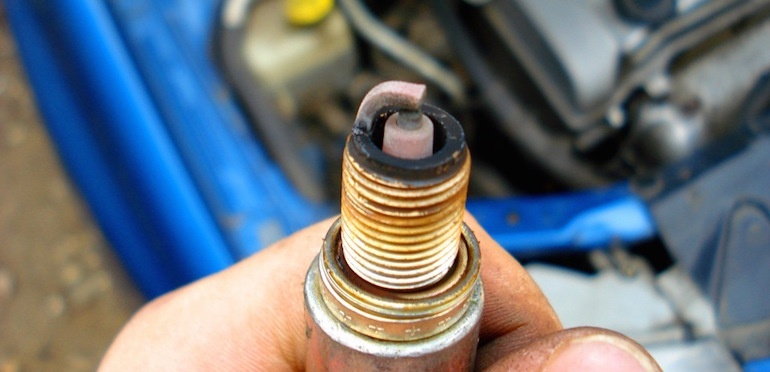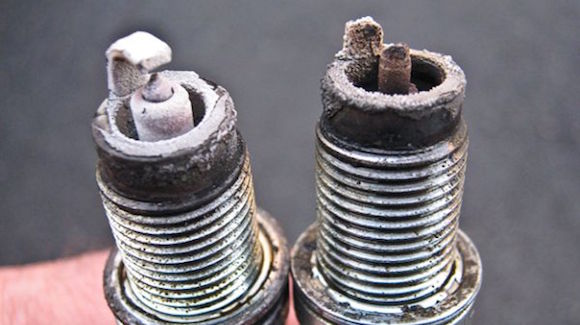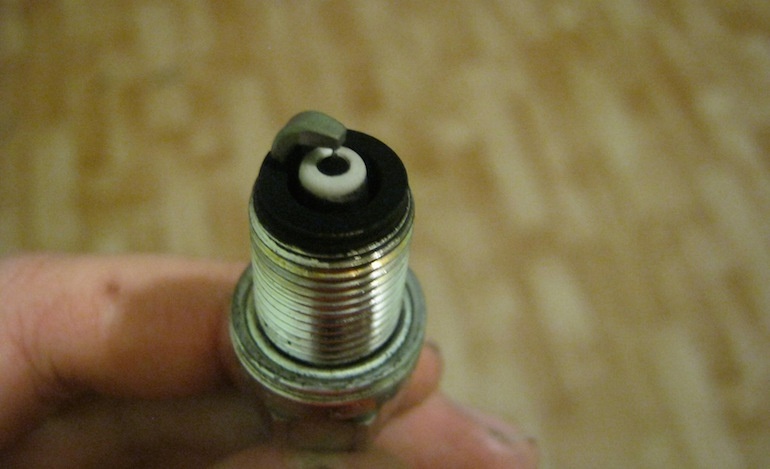
Carbon deposits on spark plugs - causes, black, red, brown
To diagnose the condition of a car engine, it is not necessary to go to a service station, you can use simple methods. First of all, you can judge the state of the system by the color of the smoke coming out of the pipe: if it is not colorless, but black, whitish, bluish, then there are breakdowns in the cylinder-piston group, due to which fuel consumption increases, more oil is consumed.
In addition, any driver will understand that something is wrong with the engine, if it stalls on its own, traction disappears, extraneous sounds are heard. We have already written quite a lot on our portal for drivers Vodi.su about what needs to be done in certain cases: adjust the clutch on the VAZ 2109, clean the throttle, switch to better oil or fuel.

In this article, I would like to talk about diagnosing the color of soot on spark plugs. After they are screwed out of their wells, you may find that there may be black, red, or brownish deposits on the threads, the skirt, and on the electrodes themselves.
Moreover, even on two adjacent candles or on one, there may be different scale - black and oily on one side, red or brown on the other.
What do these facts indicate?
When to diagnose?
First you need to choose the right moment to dismantle the candles. Many novice drivers make one common mistake - they start the engine, let it run for a while, and after that, after removing the candles, they are afraid that they have various deposits, traces of gasoline, oil, and even small deposits of metal particles.
This does not mean that there are any serious problems with the engine. It’s just that during a cold start, the mixture is forcibly enriched, the oil does not heat up to the desired temperature, and all this soot forms.
Diagnostics should be carried out after a long engine operation, for example, in the evening, when you drove all day, preferably not around the city, but along the highway. Only then will the color of the soot reflect the actual state of the engine.

The perfect candle
If there are no problems with oil or fuel consumption, the engine is running normally, then the candle will look like this:
- on the insulator, the soot is brownish, with a hint of coffee or gray;
- the electrode burns out evenly;
- there are no traces of oil.
If you found just such a picture, then you do not need to worry - everything is OK with your motor.
Light gray, white, whitish soot
If you saw just such a color of soot on the electrodes and insulator, then this may indicate several problems at once.
- Overheating, the cooling system is working abnormally due to which the candles overheat.
- You are using gasoline with the wrong octane rating. Lean fuel-air mixture.
- As an option, you can still assume that you have chosen the wrong candle - deal with the marking of spark plugs. Also, the reason may lie in the ignition timing, that is, it is necessary to adjust the ignition system.
If measures are not taken in time, this can result in a gradual melting of the spark plug electrodes, burning out of the combustion chambers, piston walls and valves.

Also pay attention to the consistency of the soot itself: if it lies in a thick loose layer, this is direct evidence of the poor quality of oil and gasoline. Just clean the spark plugs, change the oil, switch to a different gasoline and things should change. If the surface is glossy, then all the above reasons should be taken into account.
Red, brick red, yellowish brown deposits
If the insulator and electrodes have acquired a similar shade, then you are using fuel with a high content of various additives, which include metals - lead, zinc, manganese.
In this case, there is only one solution - to change the fuel, start driving to another gas station. It is not necessary to change candles, it is enough to clean them from soot.
If you drive on such gasoline for a long time, then over time, starting the engine will become more difficult due to the formation of a metal coating on the insulator and it will begin to pass current, the candles will stop sparking. It is also possible to overheat the engine with all the ensuing consequences - burnout of valves and combustion chambers.

Black carbon
If you see just such a soot, then you need to pay attention not only to the color, but also to the consistency.
Velvety black dry - mixture too rich. Perhaps the problems are related to the incorrect operation of the carburetor or injector, you use fuel with a higher octane rating, it does not burn completely and foreign combustion products are formed. Also, such scale can indicate a clogged air filter, unregulated air supply, the oxygen sensor is lying, the air damper is not working correctly.
Black oily, soot not only on the skirt and electrodes, but also on the threads there are traces of oil or ash - this is possible after a long idle time of the car, especially in winter, or immediately after starting on a cold engine.

If the car is constantly on the move, then this condition indicates:
- oil enters the engine, its consumption is constantly increasing;
- selected candles have a lower glow number;
- piston rings do not remove oil from the walls;
- valve stems are broken.
Candles filled with gasoline - look for problems in the carburetor or injector, ignition timing - the spark is supplied a little earlier, respectively, unburned gasoline residues settle on the candles.
Also, this condition is possible after a cold start at sub-zero ambient temperatures - gasoline does not have time to evaporate.
If you see not only grayish, black soot, oil and gasoline residues, but also traces of metal inclusions in these contaminants, then this is an alarming sign that speaks of destruction in the cylinders themselves: cracks, chips, piston rings, valve destruction, metal particles under the valve seat.
If the insulator and electrodes have thick soot deposits, and its color can be from whitish to black, this indicates that the partition between the rings may have been destroyed, or the rings have already been completely worked out. Because of this, the oil burns out and traces of its combustion are deposited inside the engine, including on candles.
There are also such options when we observe traces of destruction of the insulator and the central electrode.
In this case, it can be assumed that the candle was defective.
It can also be about:
- early detonations, untuned valve timing;
- low octane gasoline;
- too early ignition.
In such cases, you will feel the symptoms of malfunctions: the engine troit, shocks and extraneous sounds are heard, fuel and oil consumption, loss of traction, bluish-gray exhaust.

Erosion of electrodes - the color of the soot does not play a special role. This indicates that you have not changed the candles for a long time.
If they are new, then most likely gasoline contains additives that lead to corrosion.
If you removed the candles and saw that they were not in the best condition, then it is not necessary to throw them away. After complete cleaning, they can be checked, for example, in a special pressure chamber, or simply brought to the cylinder block to see if there will be a spark. In stores, they are checked by applying voltage to the candle.
Loading…
